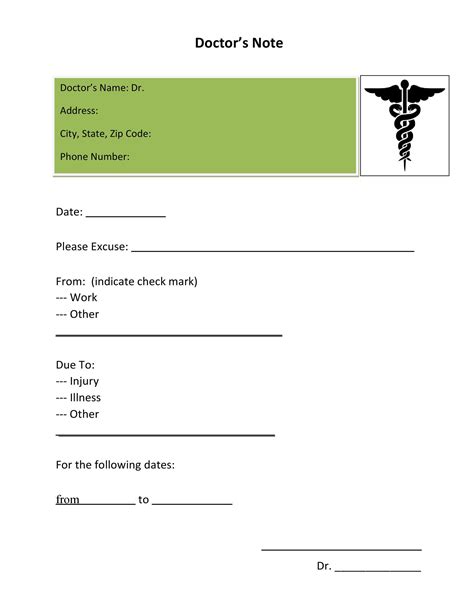When an individual is absent from work due to illness or injury, it’s common for employers to request a doctor’s note to validate the reason for the absence. This documentation serves as proof that the employee was indeed under medical care and unable to perform their job duties. The process of obtaining a doctor’s note for work involves several key considerations, ranging from the content of the note itself to the ethical and legal implications of such requests.
Understanding the Purpose of a Doctor’s Note
A doctor’s note, also known as a medical note or a doctor’s excuse, is a written statement from a healthcare provider explaining a patient’s medical condition and the impact it has on their ability to work. The primary purpose of this note is to provide evidence to employers that an employee’s absence was due to a legitimate medical reason. It helps in maintaining transparency and trust between the employer and the employee, ensuring that the employee’s leave is justified.
Content of a Doctor’s Note
A typical doctor’s note for work includes several essential pieces of information:
- Patient’s Name and Date of Birth: Basic identification to verify the patient’s identity.
- Date of Visit: The date the patient visited the doctor, which helps in establishing the timeline of the illness or injury.
- Medical Condition: A brief description of the patient’s medical condition. However, it’s crucial to maintain patient confidentiality, so the description should be general enough to justify the absence without revealing sensitive medical details.
- Impact on Work Capability: An explanation of how the medical condition affects the patient’s ability to perform their job duties. This might include any work restrictions or limitations.
- Duration of Absence: The expected duration of the absence. This can be a specific number of days or an estimate based on the typical recovery time for the condition.
- Follow-Up Appointments: If further medical evaluation or treatment is needed, this information might be included to justify future absences for medical appointments.
Ethical and Legal Considerations
Employers must navigate the legal landscape when requesting doctor’s notes. The Americans with Disabilities Act (ADA) and the Family and Medical Leave Act (FMLA) provide guidelines on what information can be requested and how it should be handled. Employers must respect employee privacy and confidentiality, requesting only the information necessary to verify the absence.
Healthcare providers also face ethical considerations. They must balance the need to provide adequate documentation for their patients’ work-related needs with the obligation to maintain patient confidentiality. The note should provide enough information to be useful to the employer without revealing unnecessary medical details.
Requesting a Doctor’s Note
Employees should understand the process of requesting a doctor’s note, including:
- Scheduling an Appointment: If the absence is due to a sudden illness or injury, scheduling an appointment as soon as possible is advisable.
- Informing the Healthcare Provider: Patients should let their healthcare provider know that they need a doctor’s note for work. This ensures the provider includes all necessary information.
- Content Specifications: If there are specific details the employer needs (e.g., work restrictions), the employee should communicate this to the healthcare provider.
Best Practices for Employers
Employers can foster a supportive and compliant environment by:
- Clear Policies: Establishing clear policies regarding doctor’s notes, including when they are required and what information should be included.
- Respecting Privacy: Ensuring that all medical information received is handled confidentially and in compliance with relevant laws.
- Flexible Leave Policies: Considering flexible leave policies that accommodate different types of absences, including those for medical reasons.
Conclusion
Doctor’s notes for work are an essential tool for verifying the legitimacy of an employee’s absence due to medical reasons. They play a critical role in maintaining the balance between ensuring that employees do not abuse leave policies and respecting their right to privacy and medical confidentiality. By understanding the purpose, content, and legal implications of doctor’s notes, both employees and employers can navigate the process effectively, promoting a fair and supportive work environment.
What is the primary purpose of a doctor's note for work?
+The primary purpose of a doctor's note is to validate an employee's absence, providing evidence that the absence was due to a legitimate medical reason.
What information should a doctor's note typically include?
+A doctor's note should include the patient's name and date of birth, date of visit, a brief description of the medical condition, its impact on work capability, expected duration of absence, and any follow-up appointments needed.
What are the ethical considerations for healthcare providers when writing doctor's notes?
+Healthcare providers must balance providing useful documentation for work purposes with maintaining patient confidentiality, ensuring they disclose only necessary information without revealing sensitive medical details.
By focusing on the key aspects of doctor’s notes for work, including their purpose, content, and the legal and ethical considerations surrounding them, we can better understand the importance of these documents in facilitating a fair and accommodating work environment for all employees.



